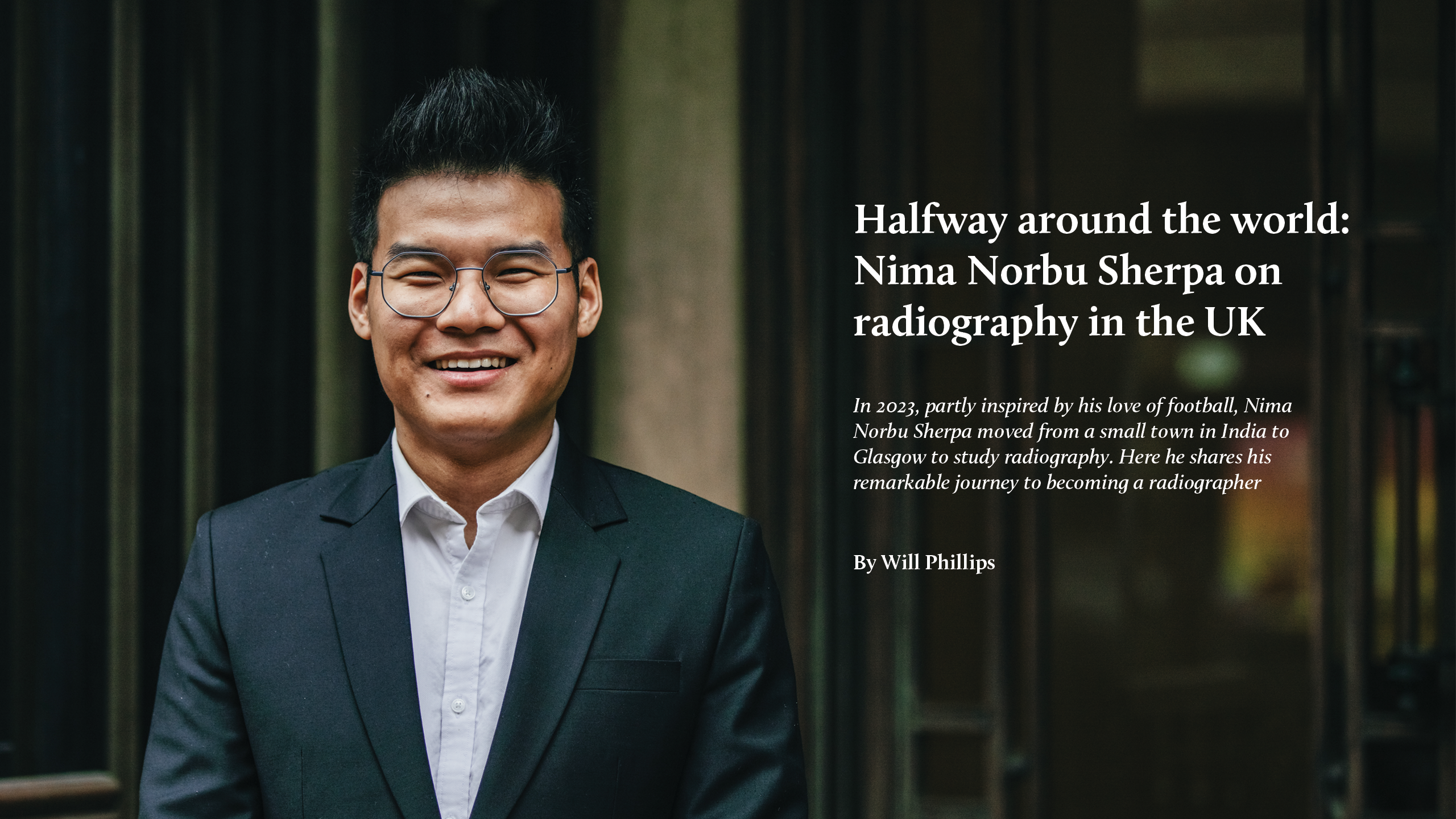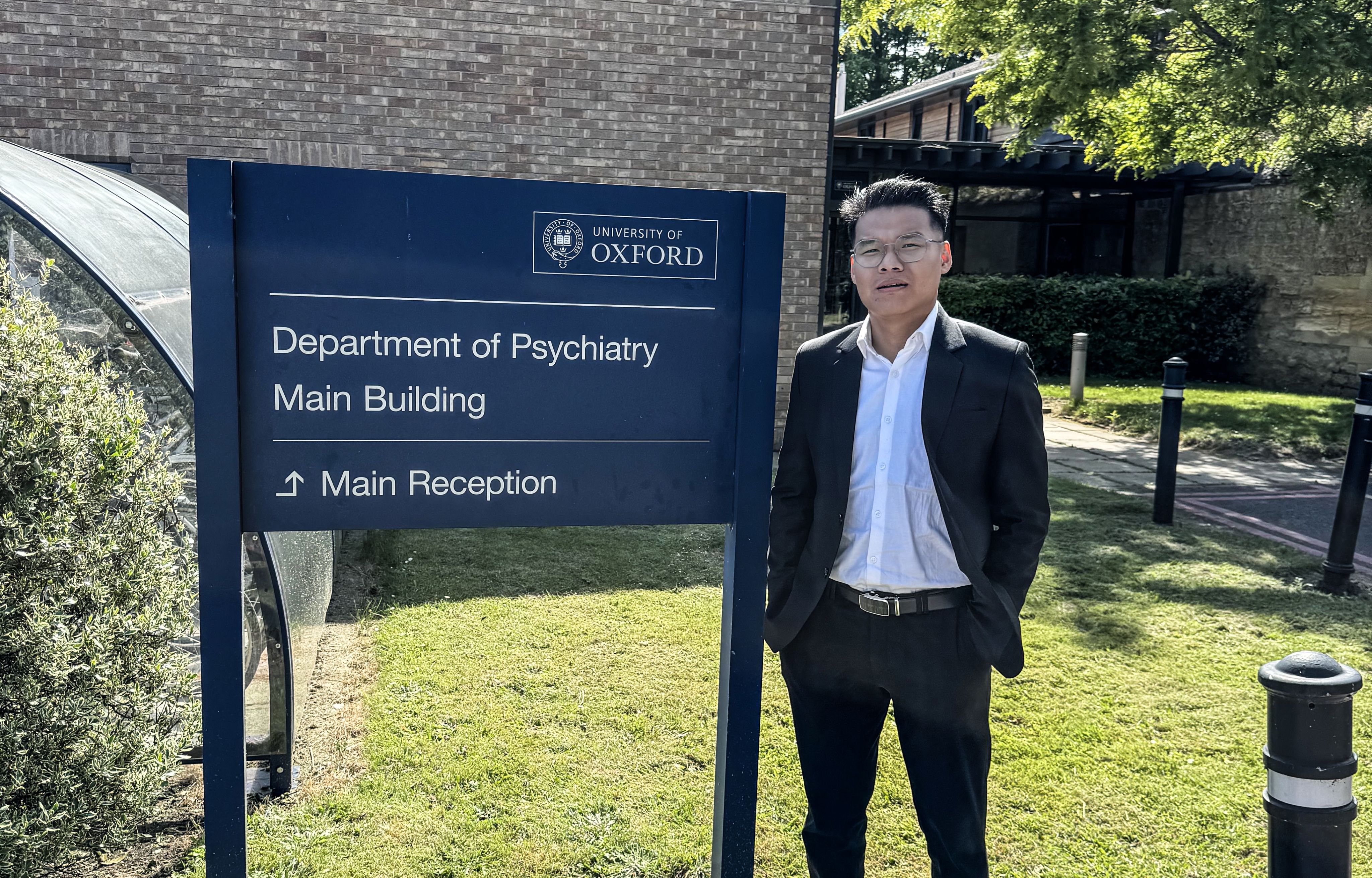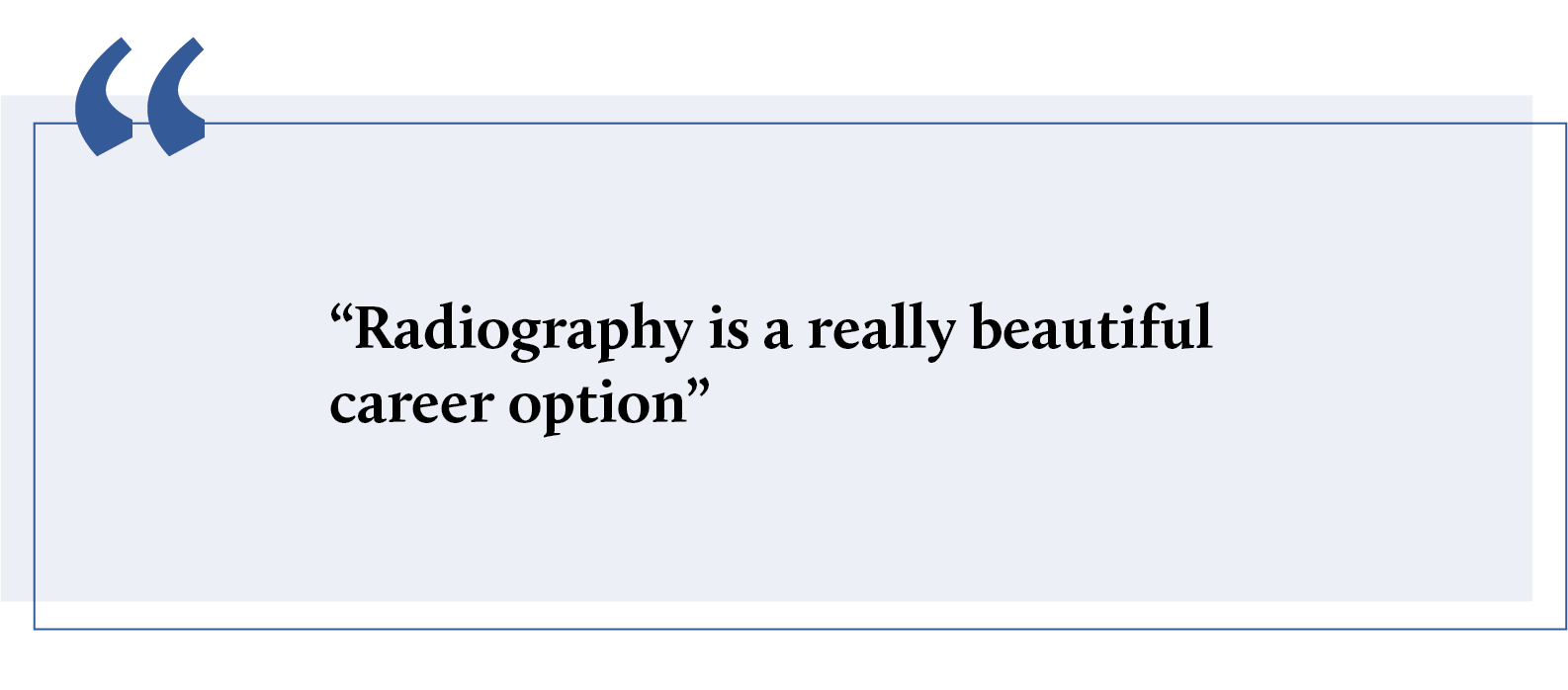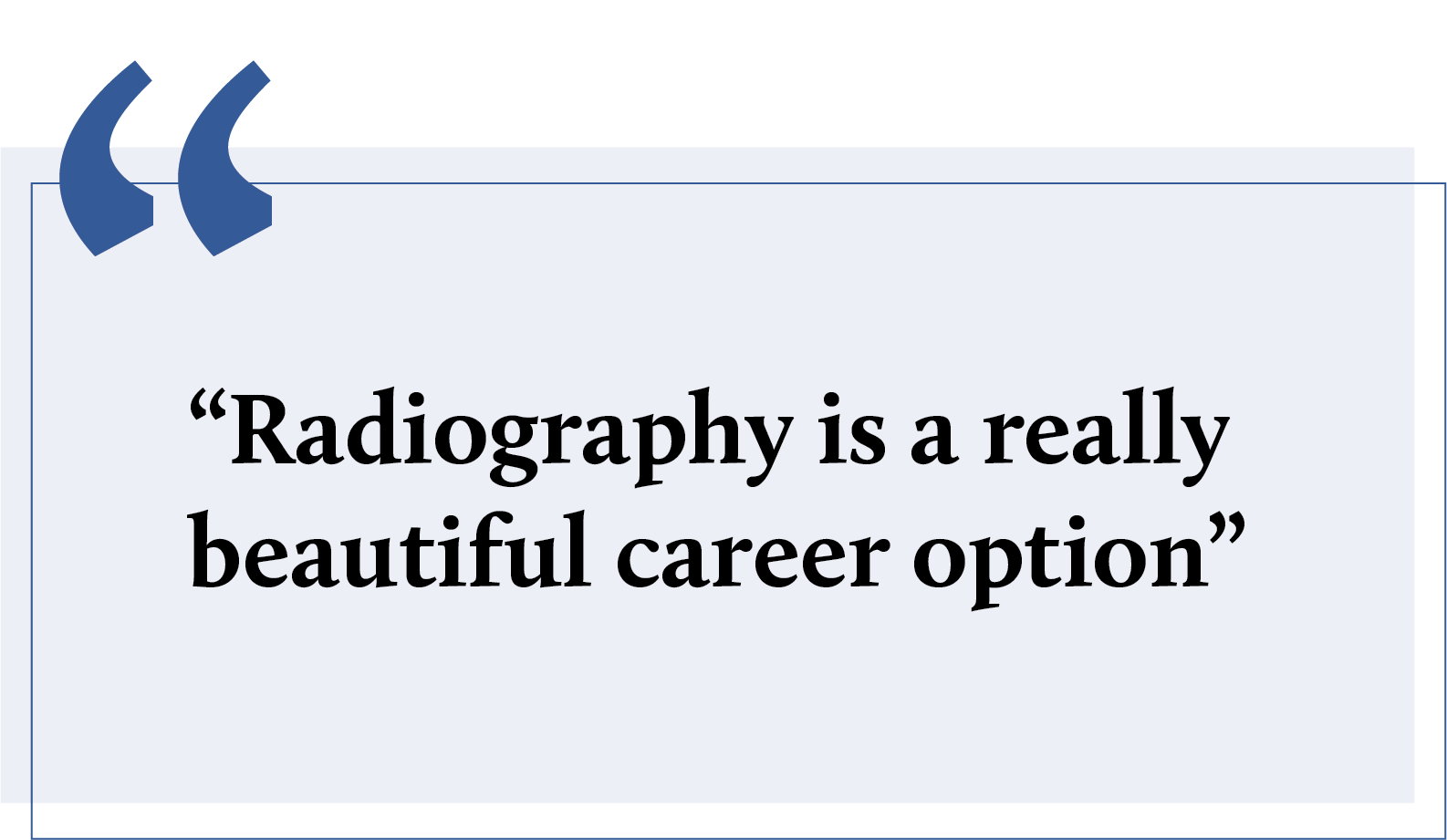
Nima Norbu Sherpa’s story is one of long journeys. In January 2023, Nima moved from a small town in Darjeeling, West Bengal in India, famous globally for tea exports, to Glasgow, where he is currently studying to become a Diagnostic Radiographer.
Partly inspired by his love of football and the beautiful views that Scotland has to offer, Nima picked up his life to pursue his chosen career. He says he has “always wanted to study in Scotland” because it is “incredibly beautiful”.
“Glasgow seems like the perfect place for that!” he said.
But the path to becoming a radiographer has not been simple for Nima, who was initially pursuing a career in psychology before finding his way to diagnostic radiography. Originally, Nima studied applied psychology – a Bachelor’s in 2016-19 and a Master’s in 2020-22 – but found during his time there he was drawn to the research aspect of psychology, rather than the clinical side.
It was during this initial foray into research that Nima found himself developing an interest in functional magnetic resonance imaging, or fMRI. This started him on a search for courses that would allow him to make use of imaging equipment and eventually on to the Master’s Diagnostic Radiography (Pre-Registration) course at the Glasgow Caledonian University (GCU).

Nima Norbu Sherpa’s story is one of long journeys. In January 2023, Nima moved from a small town in Darjeeling, West Bengal in India, famous globally for tea exports, to Glasgow, where he is currently studying to become a Diagnostic Radiographer.
Partly inspired by his love of football and the beautiful views that Scotland has to offer, Nima picked up his life to pursue his chosen career. He says he has “always wanted to study in Scotland” because it is “incredibly beautiful”. “Glasgow seems like the perfect place for that!”
But the path to becoming a radiographer has not been simple for Nima, who was initially pursuing a career in psychology before finding his way to diagnostic radiography. Originally, Nima undertook his degree – a Bachelor’s in 2016-19 and a Master’s in 2020-22 – in applied psychology, but found during his time there he was drawn to the research aspect of psychology, rather than the clinical side.
It was during this initial foray into research that Nima found himself developing an interest in functional magnetic resonance imaging, or fMRI. This started him on a search for courses that would allow him to make use of imaging equipment and eventually on to the Master’s Diagnostic Radiography (Pre-Registration) course at the Glasgow Caledonian University (GCU).
Making the leap
Nima told Synergy he was thankful for studying psychology beforehand. “There are a lot of transferable skills that I could bring from psychology to radiography,” he explains. “One of them is being empathetic towards the patients, being more compassionate towards them, especially when they are struggling or when they are in a lot of pain.
Encountering fMRI as a psychologist initially, too, was a key development that spurred him towards radiography. Nima says that, over the past decade, there has been rapid development in the way mental health research is conducted. Many new studies are using fMRI and PET scanning – meaning radiographers could make substantial contributions to mental health research in the future.
Nima explains that fMRI gives the radiographer and researchers access to real-time activity inside the brain. As a non-invasive method for observing brain function, fMRI works by finding differences in blood circulation throughout the brain. Active brain regions need more oxygen, so greater blood flow can indirectly measure neural activity. “This could then be used to understand the neurobiology of depression, or for monitoring treatment effects,” he says.
“This just blew my mind. I was like, ‘wow’. I definitely wanted to learn how to use this machine and maybe how to do more research into fMRI, psychology and radiography.”
Nima’s move to the UK has also given him insight into healthcare across the world, allowing him to compare the health service here with that of India. Of the differences, Nima says he hopes his home country would be able to make progress towards the NHS and its “unique position”.
“The UK has an excellent healthcare system,” he says. “It is essentially available to everyone at no cost when it is needed, which is wonderful because there's no concern about being able to pay for necessary care. There may be delays in seeing specialists at times, but the medical staff are highly skilled and provide a focus on promoting overall health.
“India has a combination of public and private healthcare facilities, which offers diverse options for patients. However, the NHS holds a unique position in healthcare. Hopefully, India will make significant progress in this area in the coming years.
Making the leap
Nima told Synergy he was thankful for studying psychology beforehand. “There are a lot of transferable skills that I could bring from psychology to radiography,” he explains. “One of them is being empathetic towards the patients, being more compassionate towards them, especially when they are struggling or when they are in a lot of pain.
Encountering fMRI as a psychologist initially, too, was a key development that spurred him towards radiography. Nima says that, over the past decade, there has been rapid development in the way mental health research is conducted. Many new studies are using fMRI and PET scanning – meaning radiographers could make substantial contributions to mental health research in the future.
Nima explains that fMRI gives the radiographer and researchers access to real-time activity inside the brain. As a non-invasive method for observing brain function, fMRI works by finding differences in blood circulation throughout the brain. Active brain regions need more oxygen, so greater blood flow can indirectly measure neural activity. “This could then be used to understand the neurobiology of depression, or for monitoring treatment effects,” he says.
“This just blew my mind. I was like, ‘wow’. I definitely wanted to learn how to use this machine and maybe how to do more research into fMRI, psychology and radiography.”
Nima’s move to the UK has also given him insight into healthcare across the world, allowing him to compare the health service here with that of India. Of the differences, Nima says he hopes his home country would be able to make progress towards the NHS and its “unique position”.
“The UK has an excellent healthcare system,” he says. “It is essentially available to everyone at no cost when it is needed, which is wonderful because there's no concern about being able to pay for necessary care. There may be delays in seeing specialists at times, but the medical staff are highly skilled and provide a focus on promoting overall health.
“India has a combination of public and private healthcare facilities, which offers diverse options for patients. However, the NHS holds a unique position in healthcare. Hopefully, India will make significant progress in this area in the coming years.
Above and beyond
Nima’s time at university has also been filled with a series of research projects, for which he hopes to continue on into the future. “I love research so, hopefully, after I finish my course, I will go into research. I'm interested in MRI radiography and I've seen a few adverts coming up for new radiographers.”
Nima’s research interest began during his psychology degree, where he started on a project entitled Effects of oral creatine monohydrate augmentation to cognitive-behavioural therapy in depression: an eight-week pilot, double-blind, randomised, placebo-controlled trial. This involved Nima and the rest of the team conducting novel research on the antidepressant effects of creatine, a supplement usually consumed by people with an active lifestyle, when taken along with cognitive behavioural therapy by people suffering from depression.
Over the past few months, Nima has also had the opportunity to showcase this project at the NHS Research Scotland: Annual Scientific Meeting of the NRS Mental Health Network held at University of Strathclyde. He was awarded the Best Research Poster in the People’s Choice Category.
Additionally, his research was featured as an abstract poster at the 11th MindBrainBody Symposium, organised by the Max Planck Institute for Human Cognitive and Brain Sciences in Berlin, Germany and the Edinburgh Mental Health Annual Conference 2024.
Nima has also been awarded this year’s British Association for Psychopharmacology (BAP) trainee member travel and accommodation bursary. He will travel to Birmingham in July to present a short oral session at the forthcoming BAP Summer Meeting at the University of Birmingham. “I was thrilled to learn that, from 197 research abstracts submitted, mine was chosen as one of the three for the oral sessions,” he says. “I am eager to use this opportunity to promote awareness of our radiography profession, both in clinical and research roles.”
While the manuscript is under review, Nima shares first author on the project with Dr Riccardo De Giorgi from the Department of Psychiatry at the University of Oxford. “Without his support and guidance I couldn't have achieved this,” says Nima. “I feel lucky to have him as a supervisor and mentor.”
He goes on to explain the project could be a “game changer” because conventional antidepressant medication has a lot of side effects, such as weight gain, loss of libido and changes in sleep cycle. Creatine, meanwhile, is “comparatively well tolerated and has minimal side effects”, which makes it an “ideal augmentative strategy”.
It was during this research project that Nima first came across fMRI and neuroimaging. “I am extremely grateful to my lecturers – Karen, Lucy, Sharon, Claire and Louise – for accommodating my request to attend multiple conferences and courses while on placement and classes.”
Above and beyond
Nima’s time at university has also been filled with a series of research projects, for which he hopes to continue on into the future. “I love research so, hopefully, after I finish my course, I will go into research. I'm interested in MRI radiography and I've seen a few adverts coming up for new radiographers.”
Nima’s research interest began during his psychology degree, where he started on a project entitled Effects of oral creatine monohydrate augmentation to cognitive-behavioural therapy in depression: an eight-week pilot, double-blind, randomised, placebo-controlled trial. This involved Nima and the rest of the team conducting novel research on the antidepressant effects of creatine, a supplement usually consumed by people with an active lifestyle, when taken along with cognitive behavioural therapy by people suffering from depression.
Over the past few months, Nima has also had the opportunity to showcase this project at the NHS Research Scotland: Annual Scientific Meeting of the NRS Mental Health Network held at University of Strathclyde. He was awarded the Best Research Poster in the People’s Choice Category.
Additionally, his research was featured as an abstract poster at the 11th MindBrainBody Symposium, organised by the Max Planck Institute for Human Cognitive and Brain Sciences in Berlin, Germany and the Edinburgh Mental Health Annual Conference 2024.
Nima has also been awarded this year’s British Association for Psychopharmacology (BAP) trainee member travel and accommodation bursary. He will travel to Birmingham in July to present a short oral session at the forthcoming BAP Summer Meeting at the University of Birmingham. “I was thrilled to learn that, from 197 research abstracts submitted, mine was chosen as one of the three for the oral sessions,” he says. “I am eager to use this opportunity to promote awareness of our radiography profession, both in clinical and research roles.”
While the manuscript is under review, Nima shares first author on the project with Dr Riccardo De Giorgi from the Department of Psychiatry at the University of Oxford. “Without his support and guidance I couldn't have achieved this,” says Nima. “I feel lucky to have him as a supervisor and mentor.”
He goes on to explain the project could be a “game changer” because conventional antidepressant medication has a lot of side effects, such as weight gain, loss of libido and changes in sleep cycle. Creatine, meanwhile, is “comparatively well tolerated and has minimal side effects”, which makes it an “ideal augmentative strategy”.
It was during this research project that Nima first came across fMRI and neuroimaging. “I am extremely grateful to my lecturers – Karen, Lucy, Sharon, Claire and Louise – for accommodating my request to attend multiple conferences and courses while on placement and classes.”
A significant step
Nima’s most recent project focuses on using network meta analysis to understand the impact of different medication and therapy on treating different breast cancers, for which he has received the GCU’s prestigious George and Dorothy Irving Magnusson Fellowship.
The fellowship is granted by the Magnusson Foundation every year to between four and six students, who must pitch a project and provide a written report requesting up to £5,000. “I just applied for it,” he says. “I thought ‘let’s see what happens’. After you apply for it, you get called in to pitch your idea within two minutes. That was a bit stressful, but in a good way.
“I practised a lot and somehow managed to convince them. I was really happy about it. It’s a very prestigious award and it aims to do something for the common good of people. My co-applicants had great ideas too, so that was very inspiring.”
Nima sought £1,700 for his latest research project, but the fellowship increased his grant to £2,000. He intends to use the money for attendance of a three-day “network meta analysis course” at Oxford University.
Network meta analysis is a technique for comparing three or more interventions simultaneously in a single analysis by combining both direct and indirect evidence across a network of studies. He explains: “Having the ability to network with the senior faculties out there and other researchers, to learn and develop my career as a radiographer, and then bring those skills back here to share with my friends and colleagues, would be fantastic.”
His research could be repurposed for other diseases, too. There are many medications available for different types of breast cancer, and for particular stages of breast cancer. Training in network meta analysis will help Nima understand which medication would be best suited for which particular age range, and the most likely side effects the patient would get.
While conducting his previous research, Nima first came across the network meta analysis. “I was finding it very difficult to analyse the results that we had stumbled upon,” he says. “So I approached my current mentor at Oxford and he showed me how network meta analysis could be used, and I was fascinated with it.
“My initial aim is to repurpose this for radiography and make any medications for oncology or any imaging modality more specific and tailored to our patient population.”
While radiographers in many parts of England do have prescribing rights, having a network meta analysis of how they can best be targeted will give radiographers and other allied health professionals the best estimate of what to give, keeping in mind side effect profiles. Nima adds that, every year, the evidence could be updated to help non-medical prescribers keep up with best practices and guidelines.
A significant step
Nima’s most recent project focuses on using network meta analysis to understand the impact of different medication and therapy on treating different breast cancers, for which he has received the GCU’s prestigious George and Dorothy Irving Magnusson Fellowship.
The fellowship is granted by the Magnusson Foundation every year to between four and six students, who must pitch a project and provide a written report requesting up to £5,000. “I just applied for it,” he says. “I thought ‘let’s see what happens’. After you apply for it, you get called in to pitch your idea within two minutes. That was a bit stressful, but in a good way.
“I practised a lot and somehow managed to convince them. I was really happy about it. It’s a very prestigious award and it aims to do something for the common good of people. My co-applicants had great ideas too, so that was very inspiring.”
Nima sought £1,700 for his latest research project, but the fellowship increased his grant to £2,000. He intends to use the money for attendance of a three-day “network meta analysis course” at Oxford University.
Network meta analysis is a technique for comparing three or more interventions simultaneously in a single analysis by combining both direct and indirect evidence across a network of studies. He explains: “Having the ability to network with the senior faculties out there and other researchers, to learn and develop my career as a radiographer, and then bring those skills back here to share with my friends and colleagues, would be fantastic.”
His research could be repurposed for other diseases, too. There are many medications available for different types of breast cancer, and for particular stages of breast cancer. Training in network meta analysis will help Nima understand which medication would be best suited for which particular age range, and the most likely side effects the patient would get.
While conducting his previous research, Nima first came across the network meta analysis. “I was finding it very difficult to analyse the results that we had stumbled upon,” he says. “So I approached my current mentor at Oxford and he showed me how network meta analysis could be used, and I was fascinated with it.
“My initial aim is to repurpose this for radiography and make any medications for oncology or any imaging modality more specific and tailored to our patient population.”
While radiographers in many parts of England do have prescribing rights, having a network meta analysis of how they can best be targeted will give radiographers and other allied health professionals the best estimate of what to give, keeping in mind side effect profiles. Nima adds that, every year, the evidence could be updated to help non-medical prescribers keep up with best practices and guidelines.

Be confident
Nima says the most important thing he has learned from his time as a student radiographer, doing research and applying to the fellowship, was to be confident. “Just be confident and apply,” he says. “Don’t think too much whether you would be successful, or whether you’re fit enough to apply for a grant – just apply, and see what comes your way.
“Have an open mind and make every opportunity a process of reflecting on yourself, improving on yourself. Every application you make, even if you fail, take the good points from it. Apply again and take the good points again. Do that continuously and you’ll have a positive feedback loop.”
Nima has also been able to attend one of the Society of Radiographers’ student conferences on leadership and careers in radiography with funding from the society. He highly recommends it to other radiography students. “We had a seminar about all the career options. I found that really helpful and it also helped me network with other senior clinical academics, radiographers, professors and lecturers. That really inspired me.
Aside from his studies, Nima works as a healthcare support worker for charitable organisation Quarriers, which provides care and support for people with a disability, children and families, young people, young homeless people, people with epilepsy and carers.
He was also elected as the student representative on the Scottish National Council for radiographers last October. And he serves as the assistant editor for Mental Health, Religion & Culture (Taylor and Francis Online), a mental health research journal. “That keeps me busy,” he says. “I like working. It’s when I sit idle that I start getting fidgety.”
Outside of radiography, Nima loves football – in fact, one of the reasons he came to the UK was because he was a big fan of Brighton and Hove Albion.
Be confident
Nima says the most important thing he has learned from his time as a student radiographer, doing research and applying to the fellowship, was to be confident. “Just be confident and apply,” he says. “Don’t think too much whether you would be successful, or whether you’re fit enough to apply for a grant – just apply, and see what comes your way.
“Have an open mind and make every opportunity a process of reflecting on yourself, improving on yourself. Every application you make, even if you fail, take the good points from it. Apply again and take the good points again. Do that continuously and you’ll have a positive feedback loop.”
Nima has also been able to attend one of the Society of Radiographers’ student conferences on leadership and careers in radiography with funding from the society. He highly recommends it to other radiography students. “We had a seminar about all the career options. I found that really helpful and it also helped me network with other senior clinical academics, radiographers, professors and lecturers. That really inspired me.
Aside from his studies, Nima works as a healthcare support worker for charitable organisation Quarriers, which provides care and support for people with a disability, children and families, young people, young homeless people, people with epilepsy and carers.
He was also elected as the student representative on the Scottish National Council for radiographers last October. And he serves as the assistant editor for Mental Health, Religion & Culture (Taylor and Francis Online), a mental health research journal. “That keeps me busy,” he says. “I like working. It’s when I sit idle that I start getting fidgety.”
Outside of radiography, Nima loves football – in fact, one of the reasons he came to the UK was because he was a big fan of Brighton and Hove Albion.
More about Nima Norbu Sherpa
Nima Norbu Sherpa is currently pursuing an MSc degree in diagnostic radiography at Glasgow Caledonian University. Before embarking on this course he worked as a research psychologist. Nima is particularly interested in the field of mental health research and is focused on exploring it through MRI methods.
He recently won the People’s Choice Poster Award at the NHS Scotland Research in Mental Health Annual Scientific Meeting for his research on cost-effective augmentation strategies to tackle depression. Nima is an active student member of the Scottish Society and College of Radiographers and was elected as the student representative in October 2023.
He is dedicated to raising awareness about the challenges that students face with regard to mental health issues and academic burnout across Scotland.
Read more









